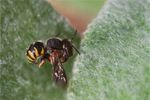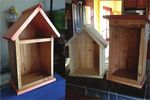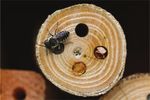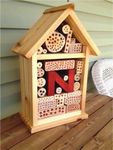NebGuide - University of Nebraska-Lincoln
←
→
Page content transcription
If your browser does not render page correctly, please read the page content below
NebGuide
Nebraska Extension Research-Based Information That You Can Use
G2256 Index: Insects and Pests, Lawn and Garden
Issued February 2015, Revised 2021
Creating a Solitary Bee Hotel
Erin C. Bauer, Entomology Lecturer
Louise I. Lynch, Assistant Professor
Doug A. Golick, Associate Professor
Tom J. Weissling, Associate Professor
This NebGuide will examine the benefits of installing to collect nectar and pollen from flowering plants for their
solitary bee hotels in your landscape and how to build them. nests; thus they serve as important pollinators.
Solitary bees vary in color and size. Many solitary bees
Many people are familiar with honeybees, which are about ¼—¾ inches in size and may be dark-colored, or
originate from Europe and are major pollinators of the metallic green or blue. Commonly observed solitary bees
world’s crops. What some people don’t realize, however, is include mason bees, leafcutter bees, and carder bees. Sol-
that there are thousands of native and non-native solitary itary bees are appealing in landscapes because they rarely
bee species that also aid in pollination. Solitary bees, unlike exhibit defensive behaviors, only stinging if mishandled or
honeybees, do not live in a social structure. Some solitary if they become entangled in clothing. Further, a solitary bee
bees nest in natural and man-made cavities. These can sting is often less painful than a honeybee. Many species
easily be provided with nesting habitats. are even stingless. Active from spring through the summer,
these bees are effective pollinators of many orchard fruits
and vegetables and aid in crop seed production.
Cavity-nesting solitary bees
Mason Bees (Osmia species)—Mason bees (Figure 1),
Each cavity-nesting female bee makes nests in loca- such as the blue orchard bee (Osmia lignaria), are the size
tions where long, tube-like holes are abundant, such as of honeybees and black to dark metallic green or blue in
hollow twigs, abandoned beetle burrows and tunnels in color. As the name suggests, blue orchard bees (BOB) are
sides of buildings, soil, plant stems, or near foundations. effective pollinators of orchard fruits. The hornfaced bee
Once a female solitary bee has chosen a nesting spot, she (Osmia corni-frons), a native of Japan, was introduced
will build cells and provide them with a single egg and into the U.S. in the 1970s and is often used to pollinate
food (nectar and pollen). In late spring, males emerge first, apple orchards. They are smaller than the blue orchard bee
wait for females to emerge near nests, and mate with them. and brownish yellow with light stripes. They have “horn”
A mated female will then begin constructing cells for her structures on their heads to help scoop up mud for nest
offspring. Solitary bees will often nest in the same area year building. New adults develop in the nest over the summer
after year if the nest site meets their needs. While solitary but will not emerge until the following spring. The mason
bees are not social, some are communal and may build bee carries pollen in a scopa, a group of stiff hairs on the
nests close to one another. Solitary bees make many trips underside of its abdomen.
1Leafcutter Bees (Megachile species)—Leafcutter
bees (Figure 2) are small to medium-sized bees with stout
bodies, dark coloration, and bands. The alfalfa leafcutter
bee (Megachile rotundata), native to Europe, pollinates
alfalfa as well as other fruits and vegetables. Like mason
bees, the leafcutter bee also has a scopa on the underside of
its abdomen for carrying pollen. They have large, scissor-
like mandibles (mouthparts) to cut leaves, flower petals, or
other vegetation to create their nest chambers (Figure 3).
Females often build more than one nest. They will rest in
the nest during the night and resume building in the morn-
ing. The end of the nest tunnel is capped off with circular
Figure 1. Mason bees. Photos: University leaf pieces. This leaf cutting activity does not harm plants.
of Nebraska–Lincoln Carder Bees (Anthidium species)—Carder bees (Figure
4) are stocky, dark-colored bees with yellow or black mark-
ings and may resemble wasps. Their name refers to their
habit of collecting plant hairs, similar to carding wool. The
females use their toothed mandibles and abdomen to comb
hairy plant leaves and stems and use the soft material to
build nest chambers. Males will patrol for females and can
be territorial, but are harmless because they cannot sting.
Why help bees . . . they pollinate!
Figure 2. Leafcutter bee nesting. Photo:
University of Nebraska–Lincoln Bees and other animals are responsible for the polli-
nation of more than 60% of flowering plants, including 95
crops in the U.S. that are pollinated by honeybees. Without
bees and other pollinators, we would not have foods like
blueberries, almonds, chocolate, and coffee.
Unfortunately, many species of wild bees have seen a
dramatic decline in their populations and historical range.
Thus, it is very important that we monitor populations of
wild bees and take actions to conserve all pollinators.
What you can do to help . . . build a bee hotel!
Figure 3. Leafcutter bee activity on rose,
oak and other leaves. Photo: University of While female solitary bees nest individually in naturally
Nebraska–Lincoln occurring cavities, they can be encouraged to nest locally by
providing a “bee hotel.” Building a bee hotel requires just a
few key materials. First, create a frame, or wooden box, that
is open in the front and closed in the back with a roof to
keep rain from saturating the nesting blocks (Figure 5). Sec-
ond, create several nesting blocks (enough to fill the frame)
(Figure 6). Nesting blocks can be made from pieces of wood,
such as small logs or 2” X 4”s cut into smaller pieces.
The bee hotel outer structure and nesting blocks can
be made from a variety of common wood such as pine,
spruce, and oak. See Figure 5 for examples. Do not use
Figure 4. Carder bee. Photo: University of pressure-treated wood, as the chemicals infused into the
Nebraska–Lincoln wood may be harmful to nesting bees. Cedar can be used,
2but it should be seasoned. Fresh cedar’s aromatic nature
may repel some bees. Wood may be found around the
home (i.e., cut limbs from pruning and logs) or through
construction companies that may have scrap wood. Using
such wood is a great way to reuse what might otherwise be
discarded. Be sure to only use wood from your local area to
prevent the spread of tree diseases and other pests.
Figure 5. Examples of frames. Photo:
Construction Instructions
University of Nebraska–Lincoln
Create the hotel frame—When placed outside, drilled
nesting blocks alone can suffice as solitary bee habitat (see
“Create nesting blocks” section below). However, bee hotel
frames are a creative way to offer nesting areas to many
more solitary bee species. In general, a good guideline for a
bee hotel frame is at least 6 inches deep X 10 inches wide.
However, there are no specific standards, so experi-
ment! For example, a medium-sized bee hotel frame (Fig-
ure 7) might be 6–7 inches deep, 12 inches high, 12 inches
wide, with an open front, and a covered back. The frame
should also include a sloping “roof ” to deflect rain. One or Figure 6. Examples of bee hotels. Photo:
University of Nebraska–Lincoln
two coats of Danish oil, available at hardware stores, may
be applied as a protectant. Allow several days for Danish oil
odor to dissipate before installation.
Create nesting blocks—To encourage nests of differ-
ent bee species, blocks of wood should be up to 6 inches in
length, with tunnels of various hole diameters (1/16–5/8
inches) drilled into them (Figure 8). Hole diameter deter-
mines the depth of a tunnel, which should not breach the
back of the wood block (Figure 9). The larger the diameter,
the deeper the tunnel needs to be drilled. In addition to
wood blocks, logs, or posts, bamboo or pithy reed grasses,
½ inches in diameter and under, may be used as nesting
structures. Holes of varying diameters provided by these
tubular plants will help to attract different species of soli-
tary bees. Using sandpaper, smooth any rough edges on the
holes, and remove any sawdust before setting the bee hotel
out for occupancy.
The nesting blocks and tubular plant materials should
be placed and packed tightly in the bee hotel frame. Do not Figure 7. A medium-sized bee hotel. Photo:
use glue to secure nesting materials to the frame, as these University of Nebraska–Lincoln
materials need to be replaced yearly.
Installation of Bee Hotel and Observing Solitary Bees
Bee hotels are best installed during the spring, before
mid-April, to prepare for the first generation of solitary
bees emerging and searching for homes. The front of the
bee hotel should have direct sunlight throughout most of
the day, facing South to Southeast, to provide warmth to
3the growing immature bees. Bee hotels should be placed
3 to 5 feet off of the ground. Trim any vegetation block-
ing the front of the hotel. Mount the bee hotel on a 4x4
fence post (Figure 10) or to another structure by screwing
through the front of the hotel frame, through the closed
back, and into the structure.
Bee hotels will be active primarily during early and
mid-summer, with a variety of solitary bees visiting and
using them for nesting. A female bee will construct indi-
vidual chambers, called cells, throughout the length of a
tunnel. She will build a small pollen mass in a cell, deposit
an egg, isolate the cell with mud (i.e. mason bees) or plant
materials (i.e. leafcutter and carder bees), deposit pollen
with another egg, and use mud or plant materials to form
another cell. She may use several tunnels, filling each with
Figure 8. Hole diameter affects the type
many cells. Depending on the species, once a tunnel is full,
of bee that will be attracted to the nesting
block. Illustration: University of Nebraska–
she will cap it with mud or plant material to seal it from the
Lincoln elements, predators, and parasites (Figure 11).
Just prior to fall’s first hard freeze, nesting blocks with
capped holes can be moved to an outdoor location that is
protected from rodents, woodpeckers, and the elements.
Discard unused nesting blocks. Leave the empty frame
where it is. Solitary bees overwinter as pupae or adults in
the capped nesting holes. Adult bees will emerge from their
nest holes the following spring and early summer when
the weather warms. Observe blocks daily from April to
June for emerging adult bees. Once the blocks have been
Figure 9. Depth depends on the diameter evacuated (by mid-summer), discard the old wood or use
of the hole, with larger diameters requiring
in compost or campfires.
deeper drilling. Illustration: University of
Nebraska–Lincoln
After bees have emerged in the spring, insert new
nesting blocks and tubular plants in the empty bee hotel
frame. Never reuse the old nesting blocks or tubular plant
material as this can promote the spread of disease to the
next generation of bees.
Summary
Solitary bees provide a great service by pollinating
flower ing plants and crops. Local populations of soli-
tary bees can be increased by0 providing nesting habitat.
Figure 10. Bee hotel mounted on a fence
Creating bee hotels is an easy way to engage in meaningful
post in a garden. Photo: University of environmental stewardship and help native and non-native
Nebraska–Lincoln pollinators.
4References
How to Make and Manage a Bee Hotel: Instructions that Really
Work. The Pollinator Garden. https://www.foxleas.com/make-a
-bee-hotel.asp
Mader, E., Spivak, M., and Evans, E. 2010. Managing Alternative
Pollinators: A Handbook for Beekeepers, Growers, and Conser-
vations. NRAES: Ithaca, NY.
Mader, E. Shepherd, M., Vaughan, M., Black, S., and LeBuhn,
G. 2011. Attracting Native Pollinators: Protecting North America’s
Bees and Butterflies. Storey Publishing: North Adams, MA.
Figure 11. A nest cavity cross-section,
showing bee larvae and nest materials
(top and middle). Capped nest entrances
(bottom). Photos: University of Nebraska–
Lincoln
This publication has been peer reviewed. Extension is a Division of the Institute of Agriculture and Natural Resources at the
University of Nebraska–Lincoln cooperating with the Counties and the
Nebraska Extension publications are available online
United States Department of Agriculture.
at http://extension.unl.edu/publications.
Nebraska Extension educational programs abide with the nondiscrimination policies of the
University of Nebraska–Lincoln and the United States Department of Agriculture.
© 2021, The Board of Regents of the University of Nebraska on behalf of the University
of Nebraska–Lincoln Extension. All rights reserved.
5You can also read



























































